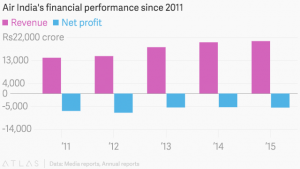Photo: wikimedia.org
Reading Time: 2 minutesIt’s straight from the horse’s mouth: Air India is in such a bad shape that nobody would want to buy it.
“Its (Air India) books are so bad. I don’t think that even if it is offered, anybody would come for it,” Indian aviation minister Ashok Gajapathi Raju has admitted.
Air India’s condition has hogged the limelight in recent years, with the company making losses since 2007 when it was merged with the domestic carrier Indian Airlines.
The merged entity proved too big to manage, and a large part of the new company’s revenue went towards paying its over 30,000 employees.
Over time, the airline aggressively borrowed from banks and financial institutions to keep up with costs and buy aircraft. As of Dec. 2015, the company had a debt of Rs50,000 crore ($7.5 billion). The airline pays an annual interest of Rs4,000 crore, which dents its profit-making ability.
In 2012, the government approved a bailout package worth Rs30,000 crore ($4.5 billion) for Air India, which was partly to be used to pay off loans.
Here’s how Air India has fared over the past few years:

The carrier’s fortunes also suffered due to the rise of private players and entry of foreign carriers in the Indian market—estimated to be the world’s third largest by 2020. In April 2016, Air India’s domestic market share was 15.1%.
Meanwhile, for years, the airline has been criticised for wasting taxpayers’ money. Now, Raju agrees that the government can’t keep using the tax income to keep it afloat.
“It is a nice airline. I like Air India but I can’t commit taxpayers’ money for eternity. That is not done,” Raju told PTI.
And there is a glimmer of hope. Air India is estimated to make an operating profit in fiscal 2016, thanks to the global oil price fall that has cut the cost of aviation fuel.

